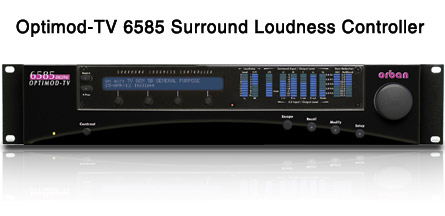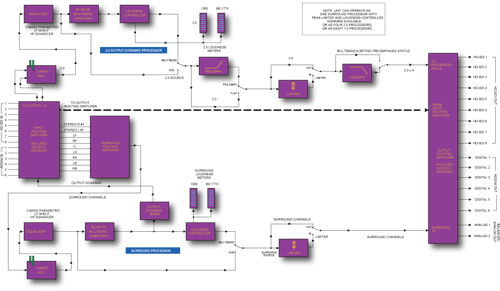
6585 Audio Processing in Detail
Experience has shown that the mass television audience wants two things from television audio: dialog should be comfortably intelligible and commercials should not be irritatingly loud compared to program material. Home theater owners may want the opportunity to watch feature films while hearing a wide dynamic range signal. However, even these viewers usually consume television in a much more passive way when viewing garden-variety programs. To be an acceptable part of the domestic environment, television sound cannot overwhelm household members not interested in viewing (not to mention neighbors, particularly in multi-family dwellings). For a variety of reasons, the dynamic range of sound essential to the intelligibility of the program should not exceed 15 dB in a domestic listening environment. Of course, underscoring and ambient sound effects will be quieter than this.
Orban understands such issues well. Since 1980, we have provided analog television broadcasters with industry-standard dynamics processors: Optimod-TV 8180, 8182, 8282, and 8382. In 1998, we introduced Optimod-DAB 6200 — two-channel processing specifically tailored for digital channels using lossy compression like Dolby's AC-3, which is used for ATSC transmissions. Our 6300, introduced in 2006, is a second-generation two-channel processor for digital channels, including DTV, DAB, and netcasting.
The 6585 features Optimod-quality two-band and five-band audio processing for surround sound broadcasting and netcasting. The multiband processing permits “automatic re-equalization” of program material. The 6585's multiband compressor can automatically re-equalize program material towards a preset target spectral balance by applying more gain reduction to frequency bands containing more power. The 6585 compressor's band coupling controls determine the maximum amount of re-equalization permitted.
In the two-band compressor, automatic re-equalization controls excessive bass, which can otherwise cause muddy balances. The five-band compressor can perform more detailed automatic re-equalization, which can be particularly useful for program material such as live news and for any material where dialog intelligibility is a problem or where de-essing is required.
Thanks to versatile compression ratio controls and a mastering-quality look-ahead peak limiter, the 6585 is also ideal for mastering audio in broadcast productions as well as productions intended for media such as DVD and Blu-ray. Our customers know that there is no substitute for the smooth, natural-sounding control that only Optimod provides, particularly with speech material.
In typical analog television practice, all audio is applied to a single transmission audio processor that automatically controls the average modulation and the peak-to-average ratio while smoothing out transitions between program elements. Simple compression and peak limiting cannot do this effectively. Starting with the 8182, all Optimod-TV processors have incorporated various generations of the CBS Loudness Controller™.
Developed after 15 years of psychoacoustic research at CBS Laboratories, the CBS Loudness Controller accurately estimates the amount of perceived loudness in a given piece of program material. If the loudness exceeds a preset threshold, the controller automatically reduces it to that threshold. The CBS algorithm has proven its effectiveness by greatly reducing viewer complaints.
In ITU parlance, the CBS Loudness Controller relies on a “short-term” loudness measurement that takes into account the human ear's loudness integration time — approximately 200 milliseconds. The CBS algorithm's attack time is fast enough to prevent audible and irritating loudness overshoots — blasts of sound that have viewers scrambling for their remote controls. Loudness control is always smooth and unobtrusive. Unlike "long-term" loudness measurement and control technologies, the CBS Loudness Controller recognizes that a piece of program material whose average loudness seems acceptable according to a long-term loudness measurement may nevertheless have short sections whose loudness should be reduced because it is extremely annoying. While main purpose of this processing is to control the loudness of commercials, other exuberantly mixed elements can also benefit. A good example is applause with whistling.
The 6585 starts with the technology of Orban's popular Optimod 6300 and takes it to the next level with surround processing that reflects the latest psychoacoustic research into loudness perception. The 6585's CBS Loudness Controller works in both two-band and five-band modes. Third generation improvements reduce annoyance better than simple loudness control alone, doing so without audible gain pumping.
The 6585 is built on Orban's mid-level hardware platform. This features a monochrome text-mode LCD and full-time LED bargraph meters. The 6585 front panel offers a simplified control and display interface that allows you to set up the technical parameters of the processing, choose a processing preset, and modify it if you wish using Orban's simplified LESS-MORE control. This interface is sufficient for most users.
A guided setup procedure called Quick Setup is available from the front panel. U.S. users can comply with the CALM Act by following it, as can European users who wish to comply with EBU R-128. Executing the Quick Setup procedure is all that is needed to implement fully effective automatic loudness control.
For those who want more control or feel that the factory presets do not entirely meet their needs, the free 6585 PC Remote software for Window® PCs displays all metering and technical parameters and allows fine-tuning of processing presets at an extremely detailed level. However, Orban's experienced audio processing experts have carefully crafted the factory presets and we believe that they will meet almost all users' needs.
Unlike audio processors built on a PC platform, dedicated Freescale 24-bit DSP chips do all audio processing in the 6585, while a separate microcontroller supports the GUI and control functions. Even if this controller malfunctions, the 6585 will continue to process audio normally.
Minimum latency of the fully processed signal is 21 milliseconds, which can be padded to exactly one frame delay for any video standard.

